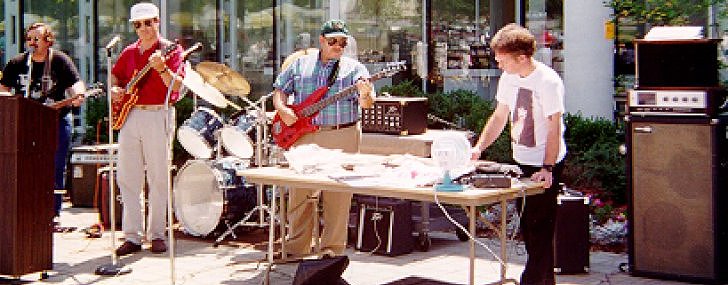
Here's a picture of the group during a company party. From left to right - Al, Mike, (Phil is at the drums), Bill, and myself. Since it's Friday, I'm wearing an Elvira shirt.
I wish I had taken pictures of this beastie, or even recorded it.
The first step was to cut open the case of the organ, and mount reed switches over the portion of the keys which uncovered the reeds. The reed switches were taken from an old pinball machine that dad had taken apart, an old Nevada game. (I wish he had kept it!).
The oscillators were discrete transistor flip-flops. Each oscillator handled 3 adjacent keys - the intent here was that I would never play anything complicated enough to use so many keys that close together. After building LOTS of FF's, I wired them up to the keys, using pots to tune each one. The outputs were bussed together and sent to an amp.
I turned the Magnus organ on, and tuned the oscillator to match the reed, then turned the Magnus off. It played, but it was all square waves which sounded wierd. The really wierd part was having the oscillators AND the reeds on at the same time. The sound was so exquisite that it would make a bagpiper cry. That bad.
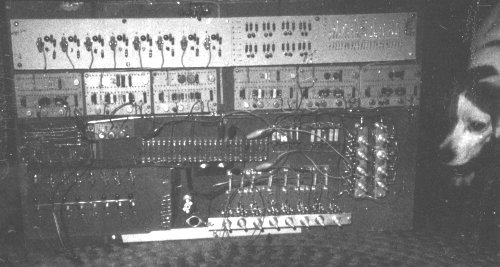
First, the Busterstop part. When we got our first dog, Barb didn't know what to name him. One day, mom referred to him as Buster and that's what it became. Buster was very curious when he was a puppy, and he'd explore behind the stove or the fridge, then get lost. Dad built several barricades to keep him out, and he called them Buster Stops.
A Sequencer is something that provides a cyclic series of events. In this case, it produces a binary sequence of 4, 8, or 16 events, each of which is connected to a potentiometer. Each of these pots can be set to give a voltage output, resulting in a sequence of preset voltages, which would go to a Voltage Controlled Oscillator (VCO). Other outputs of the sequencer would go to an envelope generator which would determine the timbre of the note (how fast it comes on, how long it takes to decay). The result is music. Of course, you have to fiddle with the adjustments, or hire people to listen.
In the picture, Buster can be seen wondering what happened to his old barricade.
The uppermost board has 8 lamp drivers to indicate the current count of the sequence, 8 level converters, and a diode pattern generator which was used with an electronic drummer. In the next row are 6 boards, each one is a flip-flop, built with discrete components. You may recognize the boards - they were sold as UNIVAC boards, but I'm not sure that they really are.
I don't remember exactly what the remainder of the ciruitry was (that was a quarter century ago), but the two groups of 8 pots are the voltage dividers which tuned each event. Most of this was rebuilt into a cabinet, and the patching was done with octal tube sockets and computer programming patch cords.
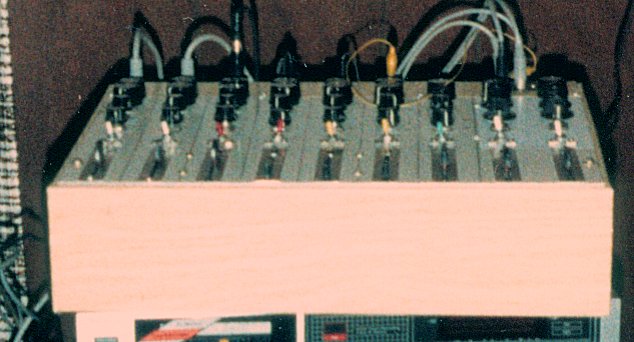
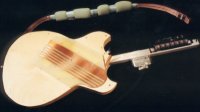
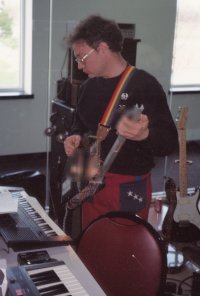
We have a company rock band, and the first time I whipped this guitar out, they all laughed. After a little strumming, they were impressed. It also drew a lot of interest during our performances. Since it's connected to a synthesizer module, I can play guitar, organ, piano or just about anything on it. My Yamaha TG33 module has a rather convincing distorted guitar which works very well on "Dizzy Miss Lizzie". I can also play guitar and strings at the same time.

Here's a picture of the group during a company party. From left to right - Al, Mike, (Phil is at the drums), Bill, and myself. Since it's Friday, I'm wearing an Elvira shirt.
On the right is the stack I was using at the time. The big speaker cabinet is a converted Sunn system. On top of that is a Heath AR-1313 receiver (70W/channel), and on top of that was a knock-off of the Bose 901, which I used as a tweeter. That was all replaced by a smaller 70 watt combo amp that I built based on an article in a 1971 issue of Radio-Electronics. The keyboard is a Yamaha PSR450, and it's connected to the TG33 module.